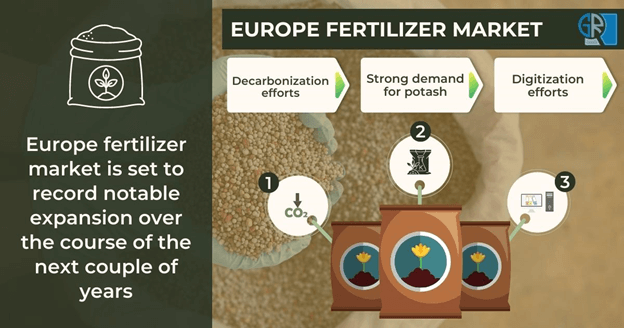Europe fertilizer market is set to record notable expansion over the course of the next couple of years. Fertilizers presently feed over half of the world's population, amounting to around 20 billion meals every day. To feed the world’s growing population, improving productivity and diversifying production toward high-value agriculture will be some key strategies to ensure sustainable agricultural growth.
Raising productivity necessitates significant expenditures in Agri-R&D, irrigation, and fertilizers, creating enormous prospects for the fertilizer industry. Listed below are the three factors analyzed to take Europe fertilizer industry to newer heights in the upcoming years:

Commitment to Europe’s decarbonization efforts
Overall, agriculture accounts for 10% of Europe's greenhouse gas (GHG) emissions. To combat this, one of the initiatives outlined by the EU is a Farm to Fork plan, which places sustainability at the center of European food policy. The measures include reducing soil and air pollution caused by extensive chemical fertilizer use. To ensure the Farm to Fork plan is on track for 2050, a preliminary set of objectives have been set until 2030.
Several companies have also chimed in with their sustainability efforts across the region. In 2022, Nutrien revealed intentions to build the world's largest clean ammonia factory. The company plans to produce clean ammonia by utilizing revolutionary technologies, which will help to achieve at least a 90% decrease in CO2 emissions, building on the company's expertise in low-carbon ammonia products, adding to Europe liquid type fertilizer industry share.
Strong demand for potash
Thanks to its features to compensate for plant deficiencies, Europe fertilizer market share from potash segment has recorded significant growth over the past couple of years. Leading companies have responded to increased demands with higher product outputs. For example, Belaruskali, a major potash company, intends to boost its potash fertilizer production capacity to 15.9 million tons by 2025.
Similarly, Nutrien raised its potash output by about half a million tons in the second half of 2021, compared to prior projections. The company boasts a versatile network of six world-class potash mines with competitively positioned, available capacity that it may use to meet global demands.
Digitization efforts in Europe fertilizer industry
The fertilizer industry has rapidly embraced digitization in recent years. In response to the increased food insecurity caused by COVID-19, fertilizer manufacturers are utilizing digital technologies to assist farmers in gaining access to fertilizers and agronomic guidance. Have a look at a few recent examples:
- Yara plans to collaborate with IBM to deliver a comprehensive global digital farming platform to the market. The companies intend to leverage their complementary capabilities. Yara's expertise and footprint in agriculture and IBM's digital platforms, expertise, and services in data analytics, AI, IoT, Blockchain, and research, will make the app beneficial to a wide base of audience globally.
- Stamicarbon is working with partners on a range of specialty fertilizers, including a biodegradable controlled release fertilizer and fertilizers containing micro nutrients. The company is also creating a suite of digital services to capture the power of real-time data in order to improve fertilizer facilities in the future. Stamicarbon is eager to engage with partners and leverage its knowledge in the utilization of renewable energy to generate sustainable fertilizer technologies.
- Nutrien's well-honed e-commerce and digital skills, like those of many fertilizer businesses concentrating on online offerings, are proving particularly valuable in ensuring products, services, and solutions continue to be effectively supplied to farmers.
There is still much to investigate and develop in order to entirely digitize the fertilizer sector. However, with the consistent inputs of industry leaders in bridging the existing gap, the future of a digitalized agriculture sector appears to be optimistic. Several industry participants, including CF Industries Holduings and Gemlik Fertilizer are trying to add to their inorganic and organic fertilizer market share in Europe.


